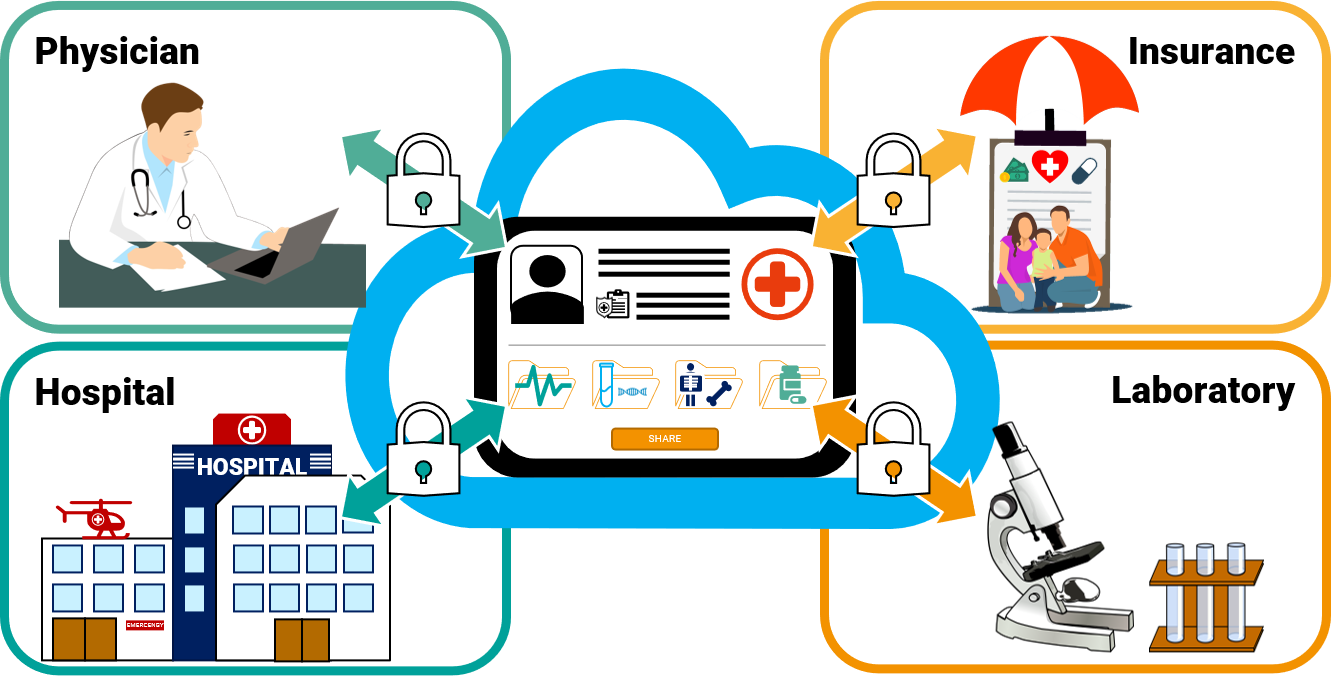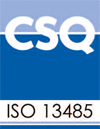Nowadays, medical records play a crucial role in fighting diseases. In recent decades, Electronic Health Records (EHRs) have been created to aid physicians and health insurance providers in effectively gathering and linking patient data to achieve better medical outcomes. EHRs have multiple objectives, such as obtaining a comprehensive view of a patient’s health and improving the speed and accessibility of data exchange between physicians, hospitals, laboratories, and insurance providers.

Figure 1 – Stakeholders for EHRs: physicians, insurance companies, hospitals or laboratories.
However, the current reality differs slightly from the initial promises of EHRs. Today’s needs have evolved since the 1960s and 1970s when the groundwork for transitioning from paper records to electronic ones was laid. To accelerate this transformation, perhaps support from the genomics field and a new unique data standard could provide the missing interoperability.
In the following sections, we will delve deeper into the evolution of EHRs, the challenges today, and how an ISO standard in genomics developed by the MPEG group could aid EHRs in the future.
The origins and current challenges of Electronic Health Records (EHRs)
However, it wasn’t until 1992 when the shortcomings of paper records became increasingly apparent, prompting the Institute of Medicine to advocate for a complete conversion to electronic health records. Despite the declining hardware costs, the widespread use of EHRs was hindered by significant initial costs, data entry errors, poor physician acceptance, and a lack of tangible incentives. As a result, the idea of a complete conversion was re-evaluated and shifted towards complementing, rather than replacing, paper records.[3]
Today, particularly in the United States, EHRs have become an established part of routine healthcare work, but they still lack better compliance with standards and information security. While significant advancements have been made in a relatively short time period, many of the early expectations for EHRs have not been met, and current EHRs do not fully satisfy the needs of today’s rapidly changing healthcare environment.[1]
| Expectations | Realizations |
| EHRs would become technically and economically feasible on a broad scale | |
| Data transmitted across high speed digital networks | |
| Each physician use an EHR | |
| Rules and regulations for patient privacy and confidentially | |
| Reduction in administrative costs of the healthcare | |
| Eliminate data duplication | |
| Computer diagnosis | |
| Save clinician time | |
| Life-long EHRs | |
| Improve patient care | |
| Pluggable medical logic modules |
Figure 2 – Comparison of the expectation for EHRs in 1992 and 2015. It shows that Electronic Health Records are possible broadly, including lifelong patient data to be transmitted quickly, reducing administrative costs and improving patient care. However, the application is still not fully adopted due to difficulties in data privacy and, most of the time, a user-unfriendly interface. This is also why duplications still occur, and due to the multitude of formats, the use of EHRs and conversion is losing the physicians’ time rather than saving it. (Legend: green = more or less realized, orange = partially realized and red = not yet realized)
How standardization can unlock the untapped potential of Electronic Health Records
In the late 1980s, the Health Level Seven International (HL7) working group was established to provide a comprehensive framework and related standards to support the exchange, integration, sharing, and retrieval of electronic health information. The goal was facilitating clinical practice and health services management, delivery, and evaluation.[5] To achieve this, a data interoperability resource called Fast Healthcare Interoperability Resources (FHIR) was developed and published in 2013.[6] The aim was to enhance EHRs by making the exchange of crucial medical data more interoperable and practical.
The main focus now is on standardizing formats to facilitate secure data exchange and enable hospitals and physicians to share medical information for better patient care. This approach includes the results of genomic testing, which generates vast amounts of medical data, particularly with the shift towards Whole-Exome Sequencing (WES) that produces gigabytes of patient data.[7] Big Data is no longer just a relevant topic for astrology or entertainment but a crucial challenge in genomics.[8] To address this, the MPEG-G was developed as an ISO standard to handle massive amounts of data while ensuring high interoperability in a standardized and user-friendly way.
MPEG-G (ISO/IEC 23092) comprises a set of ISO international standards designed to represent genome sequencing data and associated metadata. Developed by the esteemed Moving Picture Experts Group (MPEG), the standard-setting body boasts over 1,700 delegates from over 40 countries worldwide.. With over three decades of experience, MPEG has been instrumental in developing widely-used digital media encoding, transmission, and processing standards. Participation in the ISO/MPEG-G working group is open to all individuals and organizations committed to upholding an open standard’s values.
How can MPEG-G improve EHR interoperability?
MPEG-G’s genomic testing data includes relevant information for EHRs, such as the Variant Report. Conversely, previous indications in EHRs can also aid in analysis and interpretation. To fully realize the potential of electronic medical records, it is crucial to establish a standard clinical data linkage for these different data formats.
MPEG-G provides an ideal docking point for establishing this linkage. Linkage information can be stored as metadata or linkage attributes within a MPEG-G dataset, indicating the availability of additional clinical data in external repositories and how to access this data for specific samples. By making linkage information an intrinsic part of a MPEG-G dataset, it ensures the support for clinical data exploration and prevents the loss of linkage information during file transport or system migration. This feature facilitates accessing data from multiple external data repositories associated with a specific sample, including EHR systems, hospital information systems (HIS), and laboratory information systems (LIS), which may support different data exchange standards or vendor-specific solutions like HL7 and FHIR.[9]
Video 1 – MPEG-G’s interoperability feature, due to its container structure, can include metadata and attributes for the linkage of different EHRs systems and thus – for genomic purposes – can deliver the needed interoperability for medical data.
GenomSys professional’s solution leveraging the interoperability feature from MPEG-G
Our solutions are designed to operate natively in the MPEG-G format, making them an ideal choice for genomics labs seeking to leverage this innovative and efficient genomic standard.
GenomSys developed a unique multi-infrastructure genomic platform compliant with ISO/IEC 23092 (MPEG-G, “the MP3 for genomic data”), the only ISO open standard for genomic data, with CE-marked as In-Vitro Diagnostic Medical Device components to support genomic data handling organizations in the processing of these data. Our platform reduces overall costs (storage needs -70%), speeds data transmission and analyses, facilitates data reuse and accelerates time to market for advanced applications.
GenomSys MPEG-G Toolkit is part of this platform. It consists of CE-marked software tools to support organizations in implementing the MPEG-G standard and leveraging its features (e.g., smaller files, faster transmission,…). Furthermore, it includes state-of-the-art bioinformatic pipelines – MPEG-G native as well – providing efficient secondary analysis of genomic data, easy to integrate into sequencing machines and/or tertiary analyses applications.
GenomSys Variant Analyzer, which has received CE marking, is the world’s first genomic software to use MPEG-G format for processing FASTQ data, providing laboratories and researchers worldwide access to the ISO format’s high interoperability features. Using the GenomSys Variant Analyzer, the entire analysis pipeline can take advantage of MPEG-G’s features, including compression and Selective Access, which reduces overall processing time, storage and memory requirements and provides a single syntax for sharing data with colleagues.
By Lucas Laner on March 22nd , 2023.
References:
[1] Evans RS. Electronic Health Records: Then, Now, and in the Future. Yearb Med Inform. 2016 May 20;Suppl 1(Suppl 1):S48-61. doi: 10.15265/IYS-2016-s006. PMID: 27199197; PMCID: PMC5171496.
[2] Barnett GO. Computer-stored ambulatory record (COSTAR) U.S. Dept. of Health, Education, and Welfare, Public Health Service, Health Resources Administration, National Center for Health Services Research in [Rockville, Md.]; 1976. 40 p.
[3] Rodnick JE. Should the complete medical record be computerized in family practice? An opposing view. J Fam Pract 1990. April;30(4):460-4
[4] Seth Joseph; The EHR Is Dead. Long Live The EHR Platform (2021). https://www.forbes.com/sites/sethjoseph/2021/08/10/the-ehr-is-dead-long-live-the-ehr-platform-1-of-2/
[5] Health Level Seven International; About HL7 (2022). https://www.hl7.org/about/index.cfm?ref=nav
[6] The Office of the National Coordinator for Health Information Technology; FHIR® Version History and Maturity (unknown). https://www.healthit.gov/topic/standards-technology/standards/fhir-fact-sheets
[7] Manickam, K., McClain, M.R., Demmer, L.A. et al. Exome and genome sequencing for pediatric patients with congenital anomalies or intellectual disability: an evidence-based clinical guideline of the American College of Medical Genetics and Genomics (ACMG). Genet Med (2021). https://doi.org/10.1038/s41436-021-01242-6
[8] Stephens ZD, Lee SY, Faghri F, Campbell RH, Zhai C, Efron MJ, Iyer R, Schatz MC, Sinha S, Robinson GE. Big Data: Astronomical or Genomical? PLoS Biol. 2015 Jul 7;13(7):e1002195. doi: 10.1371/journal.pbio.1002195. PMID: 26151137; PMCID: PMC4494865.
[9] Nidhi Tiwari, Silvia Llorente, Jaime Delgado, Patrick Y.H. Cheung; Linkage Metadata for Enabling Clinical Data Interchange (2022)
Picture Source: Counselling / pixabay





